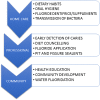Early Childhood Caries: Prevalence, Risk Factors, and Prevention
- PMID: 28770188
- PMCID: PMC5514393
- DOI: 10.3389/fped.2017.00157
Early Childhood Caries: Prevalence, Risk Factors, and Prevention
Abstract
Early childhood caries (ECC) is major oral health problem, mainly in socially disadvantaged populations. ECC affects infants and preschool children worldwide. The prevalence of ECC differs according to the group examined, and a prevalence of up to 85% has been reported for disadvantaged groups. ECC is the presence of one or more decayed, missing, or filled primary teeth in children aged 71 months (5 years) or younger. It begins with white-spot lesions in the upper primary incisors along the margin of the gingiva. If the disease continues, caries can progress, leading to complete destruction of the crown. The main risk factors in the development of ECC can be categorized as microbiological, dietary, and environmental risk factors. Even though it is largely a preventable condition, ECC remains one of the most common childhood diseases. The major contributing factors for the for the high prevalence of ECC are improper feeding practices, familial socioeconomic background, lack of parental education, and lack of access to dental care. Oral health plays an important role in children to maintain the oral functions and is required for eating, speech development, and a positive self-image. The review will focus on the prevalence, risk factors, and preventive strategies and the management of ECC.
Keywords: dental caries; dietary habits; early childhood caries; infant feeding; oral health; pediatric oral health; sociodemographic factors.
Figures
References
Publication types
LinkOut - more resources
Full Text Sources
Other Literature Sources
Medical



